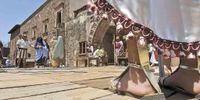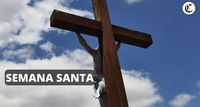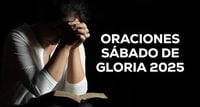As April arrives, one of the most significant religious celebrations in the Christian liturgical calendar unfolds: Semana Santa 2025, which commemorates the passion, death, and resurrection of Jesus Christ. In Peru, this celebration is marked by deep devotion and cultural richness, where various regions across the nation engage in diverse traditions and activities related to this religious festivity. Semana Santa also brings public holidays that allow the population to break from their routines. Here, we detail everything you need to know.
When Does Semana Santa 2025 Begin and End?
Semana Santa in Peru, an important date in the Christian calendar, begins on Sunday, April 13, 2025 (Domingo de Ramos) and concludes on April 20, 2025 (Domingo de Resurrección). During these days of festivities, numerous Christian and Catholic processions, masses, Via Crucis, and cultural activities will take place. Below is the schedule for the Christian commemoration in our country:
- Domingo de Ramos: April 13
- Lunes Santo: April 14
- Martes Santo: April 15
- Miércoles Santo: April 16
- Jueves Santo: April 17
- Viernes Santo: April 18
- Sábado Santo: April 19
- Domingo de Resurrección: April 20
How is Semana Santa Celebrated in Peru?
The cultural diversity of Peru is reflected in the various ways Semana Santa is commemorated in different regions of the country. For instance, in Ayacucho, processions and flower carpets are created in several locations throughout the city, attracting thousands of tourists each year. In Cusco, the procession of the Señor de los Temblores takes place, where devoted followers traverse the main streets. In Lima, citizens traditionally visit churches and attend masses. Here’s a brief overview of the significance of each day during Semana Santa:
- Domingo de Ramos: This day marks the beginning of Semana Santa and commemorates Jesus' entry into Jerusalem, according to the Gospel. On this date, Christian and Catholic churches celebrate masses and palm processions.
- Lunes Santo: The second day of Semana Santa, which recalls Jesus expelling merchants from the temple of Jerusalem.
- Martes Santo: Reflects the biblical passage where Jesus meets with his apostles and tells them that one will betray him.
- Miércoles Santo: Marks the end of Lent and commemorates the day Judas Iscariot betrayed Jesus.
- Jueves Santo: Remembers the celebration of the Last Supper.
- Viernes Santo: Commemorates Jesus' passion and crucifixion at Calvary or Golgotha in Jerusalem. Some believers observe fasting and abstinence during this day.
- Sábado de Gloria: The eve of resurrection.
- Domingo de Resurrección: One of the main festivities in Christianity, celebrating Jesus' resurrection.
When Are the Holidays for Semana Santa 2025?
In the context of Semana Santa 2025, the first long holiday of the year will occur on April 17 (Jueves Santo) and April 18 (Viernes Santo). This will be complemented by Saturday, April 19, and Sunday, April 20, which are regular days off, resulting in four consecutive days of rest.
These national holidays will allow workers, both in the public and private sectors, to take a break. However, for non-working days, it will not be mandatory for the business sector unless there is an agreement between employers and employees.
What Do Easter Eggs Mean During Semana Santa?
Easter eggs, rooted in both pagan and Christian traditions, symbolize various meanings during Semana Santa. In their pagan origins, the egg represents life and fertility, associated with the rebirth of nature in spring. In the Christian context, Easter eggs take on a deeper significance, symbolizing the resurrection of Jesus Christ after his crucifixion. The empty egg reflects Jesus' empty tomb and the new birth that occurs with his resurrection. The tradition of decorating Easter eggs signifies renewal and change, marking the transition from winter to spring and celebrating victory over death.
Given all this, we can say that Easter eggs during Semana Santa hold a multifaceted significance that encompasses symbols of fertility and the renewal of nature, as well as deeply Christian representations of Jesus' resurrection and the hope of eternal life.
Reflections on Sábado Santo 2025
Sábado de Gloria, also known as Sábado Santo, is a day of silence, reflection, and hope following the Passion experienced on Viernes Santo. It is a time to strengthen faith and prepare with open hearts for the light of the Resurrection. This day, celebrated on April 19, 2025, is marked by prayer and family gatherings.
Since 1953, Sábado Santo has been the name given to this day when evening masses were allowed during Semana Santa. The day commemorates Jesus' time in the sepulcher, according to Christian tradition, and its origins date back to the 2nd-century Christian communities who dedicated this day to prayer and fasting.
Over the centuries, the Church incorporated the Vigilia Pascual, a nocturnal ceremony that includes the blessing of fire, the liturgy of the Word, baptism of new believers, and the Eucharist, marking the arrival of Easter.
In Mexico, this day has also been associated with popular manifestations such as "mojarse" (getting wet) with water, a custom that originally symbolized spiritual purification. However, authorities in various cities have reminded people that wasting water is prohibited and can lead to sanctions, promoting more respectful forms of celebration. In 2025, dioceses called for living Sábado de Gloria with contemplation, participating in night vigils, and returning to the original sense of this date: a hopeful wait for the resurrection, a symbol of renewal and new life.
As we approach the conclusion of Semana Santa 2025, many communities engage in processions and representations, along with religious and cultural activities. This year, the dates are as follows: Domingo de Ramos (April 13), Jueves Santo (April 17), Viernes Santo (April 18), Sábado de Gloria (April 19), and Domingo de Resurrección (April 20).






